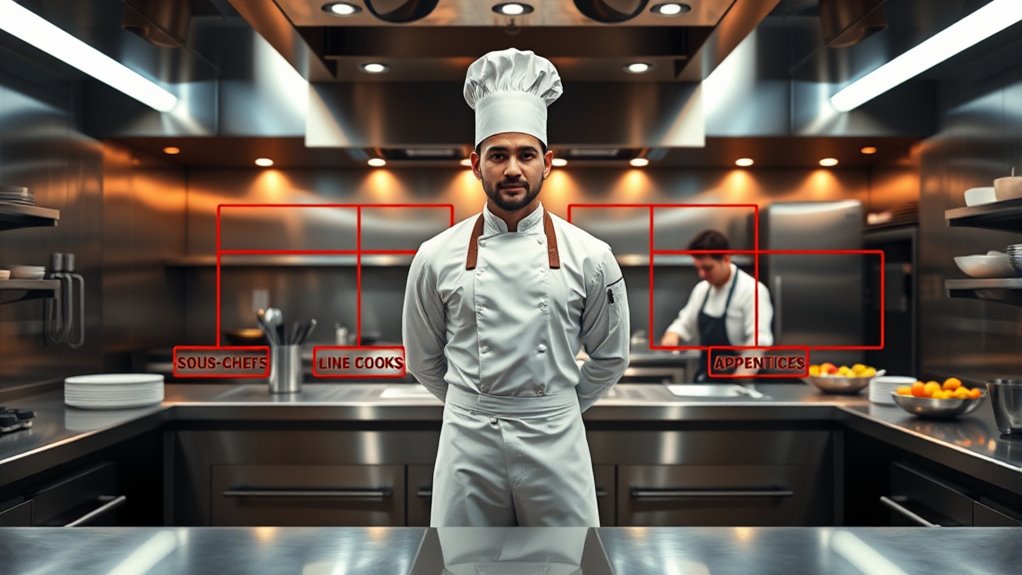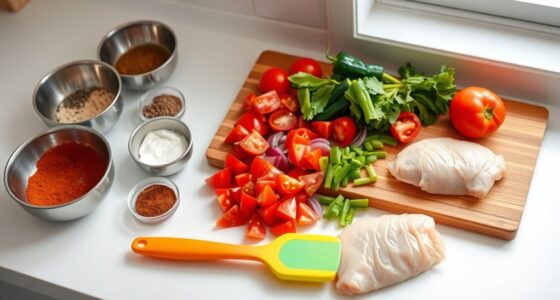The brigade de cuisine hierarchy organizes kitchen roles into a clear structure to keep everything running smoothly and efficiently. You’ll find the executive chef leading the team, with the sous chef managing daily operations. Chefs de partie oversee specific sections like pastry or sauces, while commis chefs assist. Specialized roles, such as the pastry chef and garde manger, focus on desserts and cold dishes. The expeditor guarantees communication flow. Continuing will give you a detailed breakdown of how each role contributes to culinary excellence.
Key Takeaways
- The Brigade de Cuisine was developed by Auguste Escoffier in the 19th century to organize kitchen roles and improve efficiency.
- It features a hierarchical structure with roles like Executive Chef, Sous Chef, Chef de Partie, and Commis Chef.
- The Executive Chef oversees overall operations, menu development, quality control, and staff management.
- Chefs de Partie specialize in specific sections, such as pastry, sauces, or cold dishes, ensuring skill mastery and workflow efficiency.
- The Expeditor acts as the communication link between kitchen staff and front-of-house, maintaining order and presentation standards.
The Origin and Significance of the Brigade De Cuisine
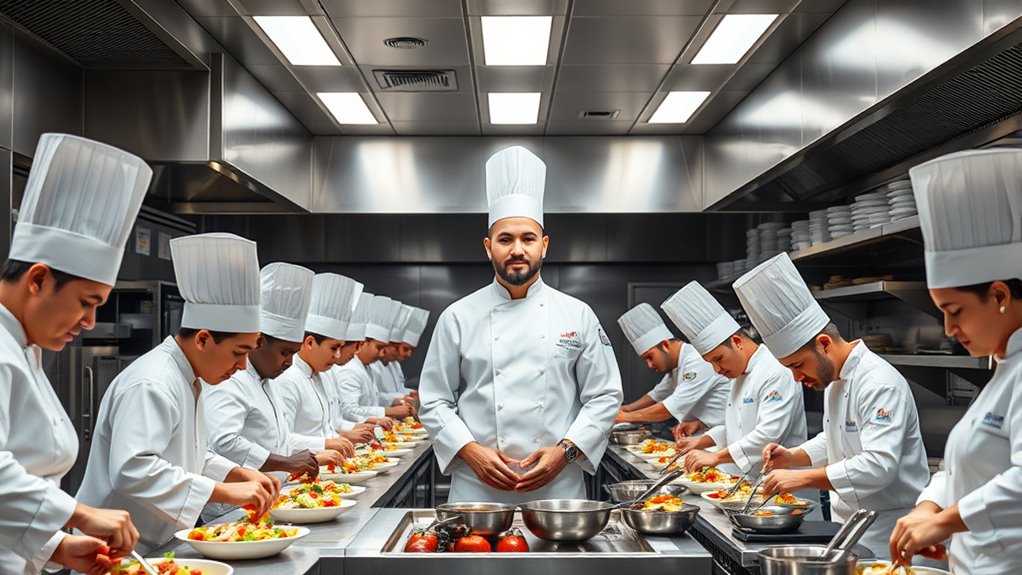
The Brigade de Cuisine, developed in the 19th century by famous chef Auguste Escoffier, revolutionized kitchen organization by creating a clear hierarchy of roles and responsibilities. Before this system, kitchens lacked structure, leading to confusion and inefficiency. Escoffier’s approach formalized roles, ensuring every task had a designated person, which improved coordination and productivity. This hierarchy also emphasized discipline, consistency, and professionalism, enabling kitchens to handle larger volumes and complex menus. The brigade’s significance lies in standardizing kitchen operations worldwide, making culinary work more efficient and manageable. It also fostered specialization, allowing chefs to perfect their skills within specific roles. Overall, this system transformed kitchens from chaotic spaces into organized, efficient environments essential for modern culinary success.
The Executive Chef: The Kitchen’s Leader
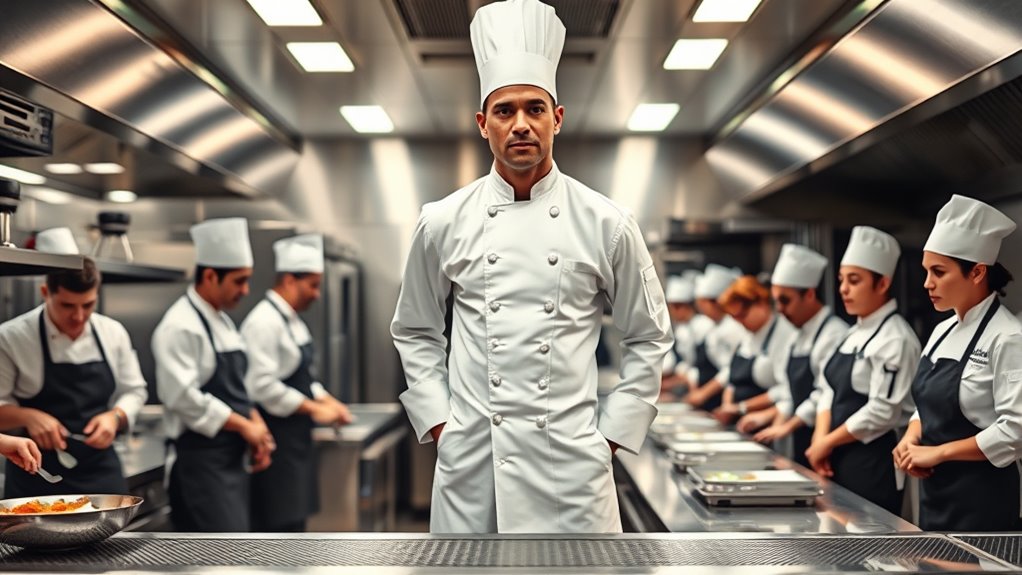
As the kitchen’s leader, you are responsible for managing overall operations, ensuring everything runs smoothly. You oversee menu development and maintain quality standards to satisfy every guest. Your leadership guides staff coordination, motivating your team to work efficiently and harmoniously. Additionally, understanding team dynamics can enhance collaboration and overall performance in the kitchen.
Overall Kitchen Management
Ever wondered what keeps a busy kitchen running smoothly? It’s the executive chef’s skill in overall management. You oversee staff coordination, ensure timely prep, and maintain high standards. Clear communication is key—you set the tone and expectations. Delegating tasks effectively helps prevent chaos, so you trust your sous chefs and line cooks. Monitoring inventory and budgeting also falls under your role, ensuring the kitchen stays efficient and profitable. To illustrate, here’s a quick look at your responsibilities: Kitchen Hierarchy
| Management Aspect | Key Focus |
|---|---|
| Staff Coordination | Assigning roles, maintaining morale |
| Inventory & Budgeting | Cost control, stock levels |
| Quality Standards | Consistency, safety |
| Workflow Optimization | Smooth operations, timing |
Your leadership guarantees the kitchen functions seamlessly, delivering excellent dishes every time.
Menu and Quality Control
Maintaining high standards for your menu and ensuring consistent quality across all dishes are central to your role as the executive chef. You must carefully develop and refine your menu, balancing creativity with practicality, and considering seasonal ingredients and customer preferences. Regular tasting sessions help you monitor consistency and identify areas for improvement. Implementing strict quality control measures guarantees each dish meets your standards before reaching the customer. You oversee ingredient sourcing, working with suppliers to guarantee freshness and reliability. Training your team on proper techniques and presentation maintains uniformity. Your attention to detail and commitment to excellence directly influence the restaurant’s reputation, customer satisfaction, and overall success. By controlling quality at every stage, you uphold the integrity of your cuisine and brand. Additionally, staying informed about AI in retail success can offer innovative ways to optimize your kitchen operations and inventory management.
Staff Coordination and Leadership
Effective staff coordination and leadership are essential for a smooth-running kitchen, where the executive chef sets the tone and guides the team. As the leader, you’re responsible for ensuring everyone works harmoniously towards common goals. Clear communication is key; you must delegate tasks effectively and provide constructive feedback. By fostering a positive environment, you motivate your staff to perform at their best. Your ability to adapt to challenges quickly keeps operations running smoothly. Leading by example, you demonstrate professionalism and dedication, inspiring confidence in your team. Building strong relationships with each team member helps you identify strengths and address weaknesses. Staying aware of industry market trends can help you make informed decisions about menu planning and staffing. Ultimately, your leadership directly impacts the kitchen’s efficiency, morale, and the quality of the dishes served.
The Sous Chef: The Deputy of the Kitchen
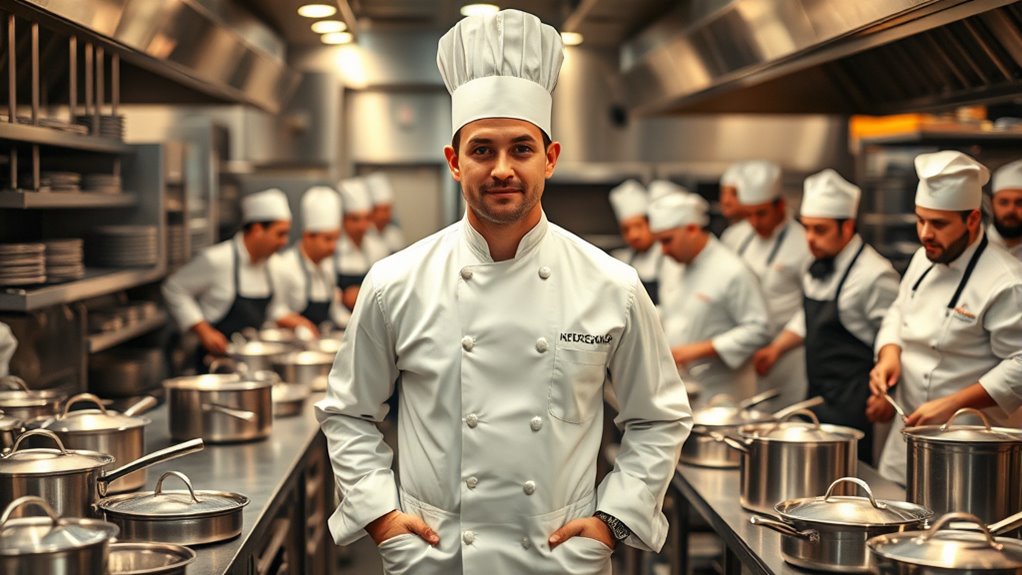
The sous chef plays a vital role as the deputy of the kitchen, stepping in to manage operations when the head chef is absent. You’ll oversee daily activities, coordinate staff, and guarantee quality standards are met. Your responsibilities include supervising prep work, maintaining kitchen cleanliness, and assisting with menu execution. You’re the bridge between the head chef and station chefs, ensuring smooth communication. To better understand your role, consider this quick comparison: High refresh rates enhance your ability to respond swiftly during fast-paced service.
The Chef De Partie: the Station Chiefs
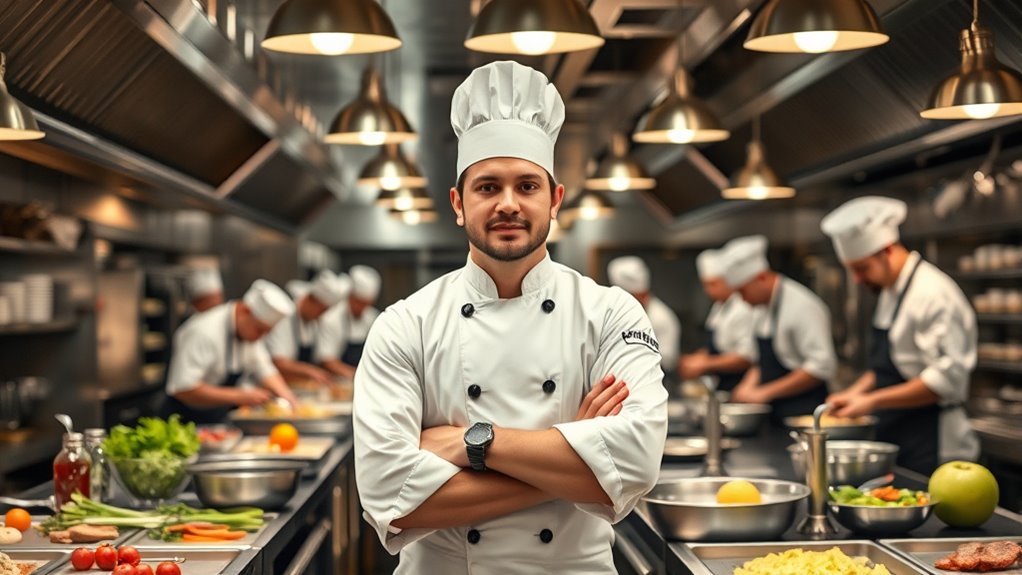
Have you ever wondered who manages specific sections of a busy kitchen? That’s the Chef De Partie, or station chief. You’ll find them leading a particular station—like sauces, fish, or pastries—ensuring everything runs smoothly. They’re responsible for preparing and cooking dishes to high standards, supervising junior staff, and maintaining quality. You’ll see them coordinating with other stations to keep the kitchen flowing seamlessly. Their expertise keeps the station organized, clean, and efficient. The Chef De Partie is a crucial link between the sous chef and the junior cooks, translating orders into precise actions. They handle their section’s workload under pressure, maintaining consistency and speed. In essence, they’re the cornerstones of a well-oiled brigade, ensuring each part of the kitchen functions flawlessly. Effective communication within the brigade is essential for maintaining kitchen efficiency and delivering excellent dishes.
The Commis Chef: The Junior Assistants
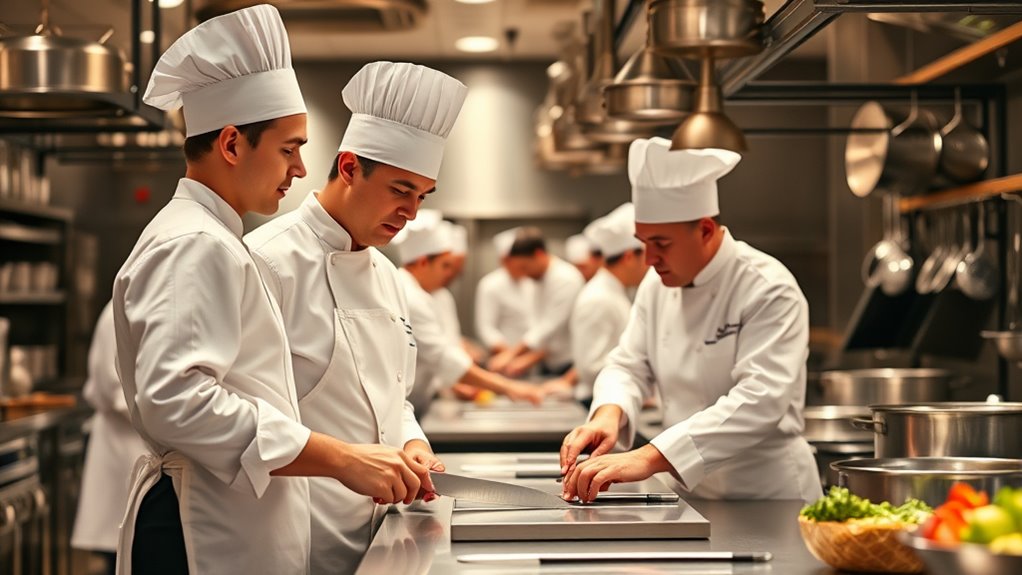
As the backbone of a busy kitchen, Commis Chefs play a vital role in supporting the senior staff and ensuring smooth operations. You’re often the first to arrive and the last to leave, assisting with prep work, cleaning, and basic cooking tasks. Your job is to learn quickly and follow instructions carefully, gaining hands-on experience under the guidance of more senior chefs. You’ll handle simple duties like chopping vegetables, preparing ingredients, and setting up stations. This role is essential for developing your skills and understanding kitchen workflows. While you may not make final decisions, your contribution keeps the kitchen running efficiently. It’s a stepping stone, helping you grow into a more skilled and confident chef in the brigade hierarchy. Utilizing unique and creative kitchen tools can further enhance your learning experience and efficiency in the kitchen.
The Pastry Chef: The Art of Desserts and Baking
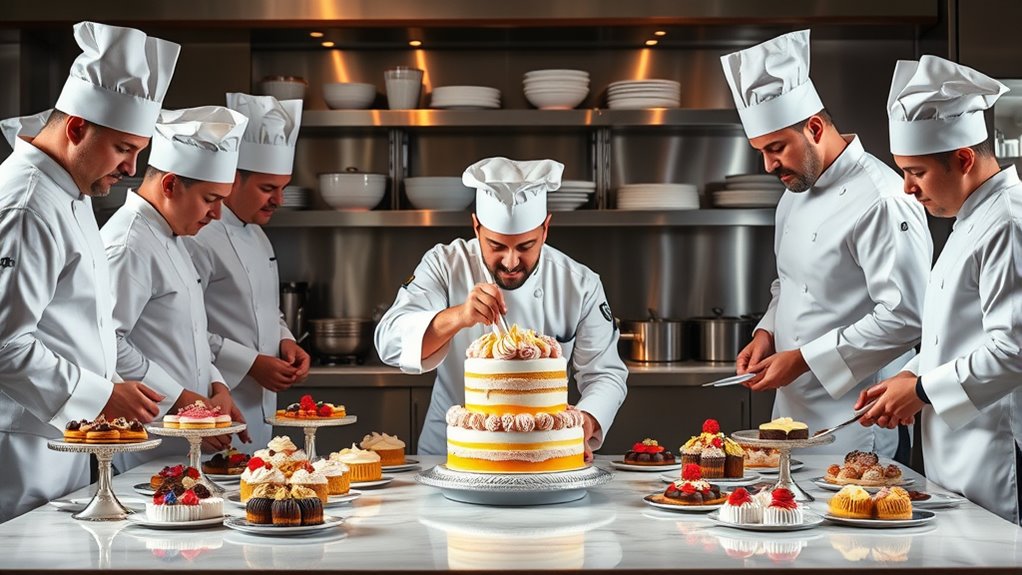
As a pastry chef, you master intricate techniques that bring desserts to life. You carefully craft each presentation to delight the eye as much as the palate. Your expertise in baking ingredients guarantees every creation is perfect, from flaky croissants to delicate tarts. Studying anime movies and animated films that touch hearts can inspire your artistic presentation and storytelling through dessert design.
Pastry Techniques Mastery
Mastering pastry techniques requires precision, patience, and a keen eye for detail. You must understand the science behind dough textures, temperature control, and ingredient ratios. Focus on developing a steady hand for tasks like lamination, piping, and glazing. To elevate your skills, pay attention to:
- Properly handling and chilling dough to prevent shrinkage
- Achieving perfect lamination for flaky puff pastries
- Mastering smooth, even fillings and custards
- Precision in piping for decorative and structural purposes
- Correct techniques for glazing and finishing desserts
- Maintaining temperature control to ensure optimal dough and filling consistency
Practicing these skills consistently builds confidence and consistency in your creations. Remember, pastry artistry balances technical expertise with creative expression, making mastery both a craft and an art form.
Dessert Presentation Art
Creating stunning dessert presentations transforms simple confections into visual masterpieces that captivate the senses. As a pastry chef, your goal is to combine artistry with precision, ensuring each plate tells a story. Use vibrant colors, varied textures, and thoughtful placement to enhance the dessert’s appeal. Attention to detail, such as delicate garnishes or drizzles, elevates the visual impact. Balance is key; too much adornment can overwhelm, while too little can seem sparse. You should consider the mood and theme of the dish, tailoring your presentation to complement flavors and ingredients. Practice consistency in execution, so every dessert looks polished and inviting. Ultimately, your skill in dessert presentation transforms a delicious treat into an unforgettable experience that excites both the eyes and palate.
Baking Ingredient Expertise
Have you ever wondered what makes a dessert truly exceptional? It’s your mastery of baking ingredients that elevates your creations. Precision and understanding of each component are essential. You need to know how different flours, sugars, fats, leavening agents, and flavorings behave under various conditions. This expertise guarantees consistent results and innovative desserts.
Some key areas include:
- Selecting the right flour for texture and structure
- Balancing sugars for flavor and browning
- Choosing fats for richness and tenderness
- Mastering leavening agents for rise and crumb
- Using flavorings to enhance complexity
The Garde Manger: The Cold Kitchen Specialist
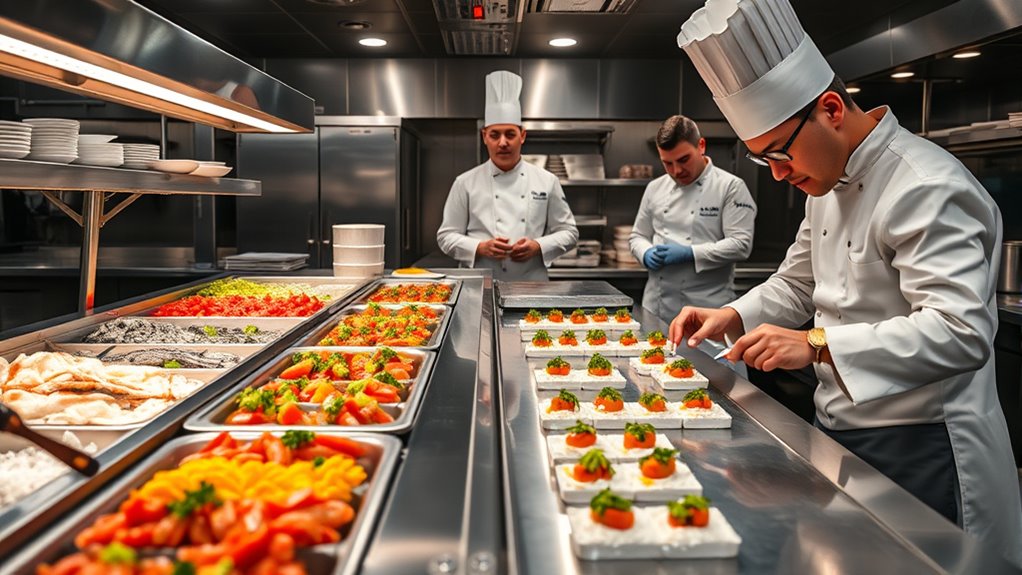
What exactly does the Garde Manger do in a professional kitchen? You’re responsible for preparing cold dishes, including salads, pâtés, charcuterie, and garnishes. Your work sets the tone for the entire dining experience, showcasing creativity and precision. You handle preservation techniques, ensuring ingredients stay fresh and vibrant. Your skills bring beauty and flavor to every plate, evoking satisfaction and anticipation.
Here’s what you bring to the team:
| Passion | Precision | Presentation |
|---|---|---|
| Creativity | Freshness | Elegance |
| Flavor | Technique | Impact |
| Dedication | Consistency | Inspiration |
Your role is essential—your artistry elevates the cold kitchen to an art form, delighting guests and inspiring chefs alike.
The Expeditor: The Communication Hub

In the bustling environment of a professional kitchen, clear communication keeps everything running smoothly, and that’s where the expeditor, or expediter, steps in as the central hub. You serve as the crucial link between the kitchen staff and front-of-house, ensuring orders are accurate and timely. Your role involves coordinating dishes, checking quality, and maintaining order during service. To excel, you:
- Relay special requests from servers to the kitchen
- Confirm dishes meet presentation standards
- Prioritize orders based on timing
- Communicate any delays or issues
- Ensure smooth flow between kitchen stations
Your quick judgment and sharp focus help prevent chaos, ensuring guests receive their meals promptly and perfectly. As the communication hub, you keep the entire brigade aligned, functioning seamlessly under pressure.
How the Hierarchy Ensures Culinary Excellence
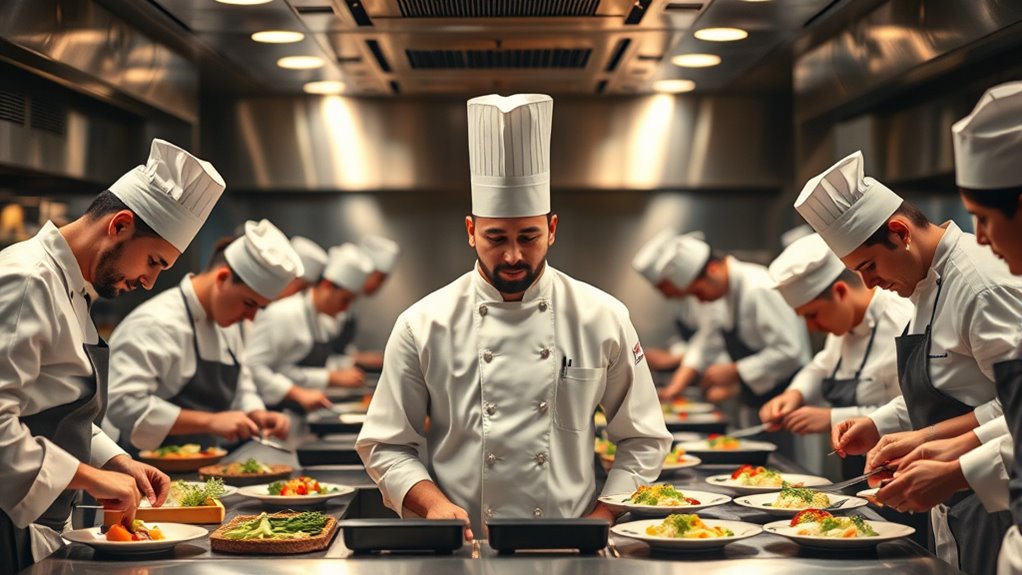
A well-defined hierarchy in a professional kitchen guarantees that every dish meets the highest standards of quality and consistency. By clearly assigning roles and responsibilities, each team member knows exactly what to do and when to do it. This structure minimizes confusion and streamlines communication, allowing for efficient coordination during busy service hours. It also promotes accountability, so everyone takes ownership of their tasks, leading to fewer mistakes. When chefs specialize in their stations, they develop expertise, which improves the flavor, presentation, and overall excellence of each dish. The hierarchy ensures that quality control is maintained at every step, from prep to plating. Ultimately, this organized system creates a seamless flow that elevates the dining experience and sustains culinary excellence.
Frequently Asked Questions
How Does the Hierarchy Adapt in Small Versus Large Kitchens?
In small kitchens, you’ll find a flatter hierarchy where roles blend, and everyone often shares responsibilities. In large kitchens, the hierarchy becomes more structured, with clear divisions of labor and specialized positions. You adapt by being flexible in smaller spaces, taking on multiple roles, while in larger kitchens, you focus on your specific duties within the chain of command. Both setups require teamwork, but the scale influences how formal or informal the hierarchy is.
What Are the Career Progression Opportunities Within the Brigade De Cuisine?
You can advance your career in the brigade de cuisine by gaining experience and demonstrating your skills. Starting as a commis, you can move up to demi chef, chef de partie, sous-chef, and eventually head chef. Each step offers more responsibility and leadership opportunities. Networking, continuous learning, and showing dedication help you climb the ranks and open new roles within the kitchen hierarchy.
How Are Conflicts Managed Within This Structured Hierarchy?
Think of the brigade as a well-oiled machine, where conflicts are sparks that need quick extinguishing. You’re encouraged to communicate openly and respectfully, addressing issues directly with your team or supervisor. Chefs and managers mediate disputes, aiming to maintain harmony and focus on the goal: delivering exceptional dishes. By fostering a cooperative environment, conflicts become opportunities for growth, strengthening the team’s bond and ensuring smooth kitchen operations.
What Specific Skills Are Required for Each Position?
When considering the skills needed for each position, you’ll find that entry-level roles require basic culinary techniques and a willingness to learn. As you advance, you’ll need strong leadership, organization, and communication skills. For executive roles, strategic thinking and creativity become essential. You should also cultivate adaptability, teamwork, and time management to succeed in every level. Mastering these skills ensures you excel in your specific position within the hierarchy.
How Does the Hierarchy Influence Menu Development and Innovation?
You see, the hierarchy shapes how you approach menu development and innovation. It creates clear roles, encouraging collaboration and idea sharing among team members. Senior chefs guide the creative process, ensuring consistency and quality, while junior staff bring fresh ideas and new techniques. This structure fosters a balanced environment where tradition and innovation coexist, ultimately leading to diverse, innovative menus that meet guest expectations and elevate the restaurant’s reputation.
Conclusion
Understanding the brigade de cuisine isn’t just about knowing titles; it’s about appreciating how each role weaves together like a symphony of flavors. When you grasp this hierarchy, you see the artistry behind every dish. It’s the secret ingredient that transforms a busy kitchen into a well-oiled masterpiece. So, next time you savor a perfectly prepared meal, remember—it’s the harmony of these roles that makes culinary magic happen.
